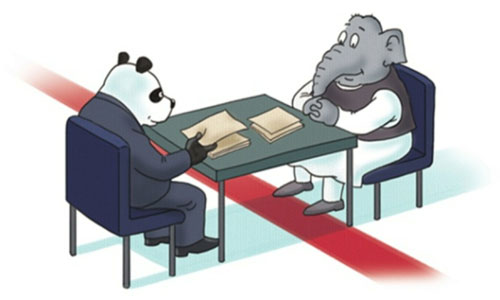Ai Jun
Tensions triggered by border disputes have been clouding China-India ties since May 2020, and India has been portraying China as the “aggressor.” Yet on Sunday, a high-level Indian politician slapped his country’s face by spilling the beans – he revealed that India has transgressed the Line of Actual Control (LAC) far more often than China did, but the Indian government has not announced it.
The Hindu newspaper quoted V.K. Singh, union minister of state for Road Transport and Highways, and a former four-star general in the Indian army, as saying, “Let me assure you, if China has transgressed 10 times, we must have done it at least 50 times.” He said so when accusing China of attempting to expand its area near the LAC.
Singh sounded just like an aggressor admitting and bragging about his aggression. The rhetoric unveiled belligerence and an expansionist policy, which is the opposite of India’sprevious narrative – India was standing up to China’s “bullying.”
The latest remarks from Singh not only embarrassed India, but also made the US and other Western countries, which have been endorsing India for a long time, look bad. Just a few days ago, Emily J.Horne, spokesperson of the National Security Council, expressed Washington’s concern over “Beijing’s pattern of ongoing attempts to intimidate its neighbors” in the new US administration’s first response to the China-India border standoff. Yet Singh quickly proved who the real “intimidator” is.
The latest round of conflicts between the two Asian neighbors began from the moment in 2020 when India violated bilateral agreements and consensus, illegally crossed the border and fired shots to threaten the safety of Chinese border troops.
Even Indian Prime Minister Narendra Modi acknowledged so in June, saying, “Nobody has intruded our border… nor have our posts been captured.” In other words, it was India that had provoked and unilaterally changed the status of the border area at that time.
However, some Indian politicians, media outlets and strategists kept promoting the wrong narratives. They twisted the facts and complained that China was the aggressive and expansionist one. As a result, voices such as “why is China expansionist? And India a relative pacifist?” and “India ‘firmly’ thwarted China’s expansionist policy” have been circulated within Indian and Western public opinion domains.
Finally, someone uttered the truth. Ironically, when Singh admitted India was the provocative side, he took such aggressive behavior as being glorious. The purpose couldn’t be more evident – he was pleasing Indian nationalists by stressing how “powerful” his party, India’s ruling Bharatiya Janata Party, is.
India is entangled in its internal puzzles. It has lost control of its COVID-19 epidemic, its economy is severely hampered by the public health crisis, and more domestic issues, such as farmers’ protest against new farm laws, are surfacing. The Indian government cannot solve any of the problems but can retain its approval rating by hyping nationalism and populism, sacrificing its ties with China.
More importantly, India has over the past few years made a wrong strategic calculation by believing it can raise its global status and influence, and even become more aggressive in the region, with the help of the US’ Indo-Pacific strategy. Yet when it comes to territorial issues, China will not back down, and India has once again been taught a lesson. More unfortunately, its trick of playing the victim has been exposed.
Now Chinese netizens share the same stance – we have proof and reason to counterattack.
Even Indian and Western Twitter users have started to ask: So India is the aggressor and China had the right to beat those Indian troops up?









